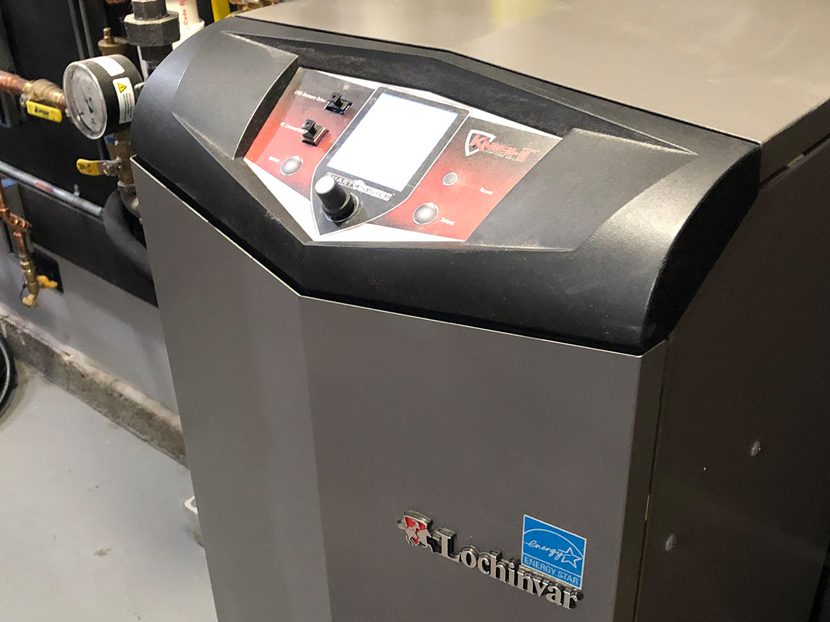Mod-Cons and Cast-Iron Radiators
Put in the work to ensure it’s the proper design for the application long before you pick up the first wrench.

“It doesn’t make any sense to use a modulating-condensing boiler with ‘high temperature’ cast-iron radiators or baseboard-type heat emitters, fin tube or cast iron. You’ll never see any savings, and it’s a complete waste of money.”
Have you ever read that or been told by someone who swears up and down that the new mod-con boiler will need to run at the same water temperature as the old cast-iron boiler? I have, too — many times.
How about this one? We’re being offered significant rebates from the local energy companies to replace that old boat anchor of a cast-iron boiler with the latest and greatest hydronic heating machine, offering efficiencies of 95 percent. Why would they hand out these obscene incentives if they weren’t certain there would be phenomenal energy reductions? Yep, heard that one, too.
Which one is right?
It depends. It depends on whether you, the company you work for or the engineers are willing and able to do the work. You must put in the work to determine which one of the arguments above holds true. If you’re not putting in the work or not speaking up, you’re just cashing a paycheck.
Every time you run into the question of whether your 95 percent AFUE modulating-condensing boiler will perform as advertised depends on the work you put into it. There is no simple yes or no to that question that I can think of.
Some of you know where I’m heading with this because I tend to say it quite a bit. The first step in any proper design and installation of a hydronic heating system is, and always will be, a Manual J heat loss load calculation. If you do not take this critical first step, everything that follows is a guess. The guesses may be right at times, but why take the chance? I live in Las Vegas and I don’t even gamble here. Somehow, I was always able to avoid that vice and it crossed over into my professional life.
This calculation for a specific job like this must be done on a room-by-room basis. A block load calculation won’t be much help here. The reason being is that we need to compare the heat loss of each room to the amount of heat being generated by the radiator(s) or baseboard in that room — not only that we need to know the heat output of the emitters at various supply water temperatures.
Once we have all this data, we can tell our customers with confidence as to whether it makes sense to go mod-con or not. We can take it a step further and show them on paper or a tablet exactly how we arrived at this recommendation. Do this and you’ll have a customer for life.
More condensing, more efficiency
Let’s do a quick review of what our goal is here. If we’re in the business of modulating-condensing boilers, we want our boilers in condensing mode as much as possible (Figure 1). We want them to run for long, extended periods of time with low return water temperatures hitting the heat exchanger.
When the return water temperature is below 135 degrees F, the flue gasses will be condensing continuously. The longer the boiler is in condensing mode, the more efficient it will be. This is something you avoid with cast-iron boilers at all costs and something you strive for with mod-con boilers. Flue gas condensation is very acidic and will eat a cast-iron boiler faster than I drink ice-cold bottles of Pepsi. A mod-con’s stainless-steel heat exchangers laugh at the acidic condensate.
Let’s look at a fictitious Victorian home that was built in the early 1940s. Building requirements were not ideal back in the day, but we’ve come a long way since then. One family owned the house for its first 60-plus years, only making cosmetic changes along the way.
At the turn of the century (how’s that for making you feel old), a young couple bought it and did a complete restoration. They updated windows and doors, added insulation and air sealing in the walls and ceilings, and installed dampers and glass enclosures on their two fireplaces. Their old, original boiler with its cast-iron heat exchanger and cast-iron doors was next on the hit list.
Guessing was even more popular than it is today, so this old beast came in at 225,000 BTU/hr. input. The house isn’t very big by today’s standards, so it was not only oversized for the uninsulated house 80 years ago, but also exceeded the equivalence of direct radiation of the existing radiators.
Remember, this house is a figment of my imagination, so it’s possible that a radiator or two were removed. I don’t know. I wasn’t there. What I do know is the updated fictional house has a heat loss of 52,536 BTU/hr. on the coldest day of the year, which happens to be a crispy 4 degrees F outside.
Calculating supply water temps
I put together a spreadsheet (Figure 2) with the following information:
• Room and room identification;
• Radiator style, height, width, number of sections and corresponding EDR;
• BTU/hr. per square feet of radiation at 180 degrees F, 170 degress F, 160 degrees F, 150 degrees F, 140 degrees and 130 degrees F;
• The corresponding heat output in BTU/hr. at the temperatures listed above.
The spreadsheet gives you concrete data to answer the question of the day. Are you going with a cast-iron boiler or a highly efficient, stainless-steel modulating-condensing boiler?
It looks like there’s a lot going on in the spreadsheet, but it illustrates the bullet points I described previously. On the left, we have the room number and the information for the radiator in that room. On the right, we have numbers that represent how much heat each radiator will deliver using different supply water temperatures. The numbers directly below the supply water temperatures represent the EDR per square foot of radiation at the temperature.
For example, Room 2’s radiator being fed 150-degree F water will deliver 52,80 BTU/hr. That radiator has an EDR of 48; its EDR/ft.² radiation is 110 — 48 x 110 = 5,280. That number is close enough to the actual room heat loss that I’m completely comfortable with it.
Remember, those water temperatures in the spreadsheet are for the supply water. Operating with a design delta T of 20 degrees F, our return water temperature for Room 2 is 130 degrees F on the coldest day of the year. That’s rocking good news in my eyes because it means that if the other rooms follow the same track as Room 2, our modulating-condensing boiler is going to be in condensing mode 90 percent to 95 percent of the heating season.
This is the work I’m talking about. Fill out a chart or a spreadsheet with accurate information, and you’ll have proof positive whether it will work.
Reviewing the remaining rooms’ Manual J heat loss compared to the heat output of the six different supply water temperatures, my choice would be to set the boiler setpoint target at 150 degrees F. Keep in mind that most load calculations have a built-in buffer and will oversize by 10 percent or so. I don’t see any problems at all with dismissing the idea of using a cast-iron boiler.
Here’s another thing to consider: The smallest mod-con boiler input I’ve seen or used is 55,000 BTU/hr. The net BTU/hr. on that size boiler is 44,000 BTU/hr., which isn’t enough to cover the load. So, you need to go with an 085, which has a net of 69,000 BTU/hr.
It doesn’t always work out this clean, though. When you run these numbers on a building and find that your return water temperatures are consistently above the condensing point, then you’ll have come up with other reasons to choose a mod-con boiler than efficiency gain. Low NOx, chimney problems, rebates?
Rebates without putting in the work to confirm you’ll get what’s being advertised is a sore spot for me. If there’s ever a debate on this, I’d like to be a participant.
More steps
Just a reminder, when installing a modulating-condensing boiler on an old system that is ripe with black iron and cast-iron pipe and fittings, there are a few more steps you’ll need to take. Here’s what I do:
• Flush the system.
• Inject a cleaner into the system and let it run hot for a few hours.
• Flush the system again.
• Have your makeup water tested; Rhomar is a good source for that.
• If the water falls within the levels recommended by the boiler manufacturer, you’re good to go. For my system, I ordered a 55-gallon drum of deionized water and used that as my fill water. Note that I closed the potable water feed and the system is protected by a low water cut-off. Two years later, the pressure remains the same as it was a couple of days after the initial fill.
• Pump in a corrosion inhibitor.
• Make it a habit to check the water quality.
• Install a quality dirt and magnetic separator; I typically use a 4-in-1 separator. Note that all magnets are not created equal.
Installing a tricked-out hydronic system is so much more than running plumb and level pipes, clean wiring and proper venting. You must put in the work to ensure it’s the proper design for the application long before you pick up the first wrench.
I really love that part of hydronics, and I love looking at that spreadsheet where everything becomes crystal-clear, making your decision a no-brainer.





